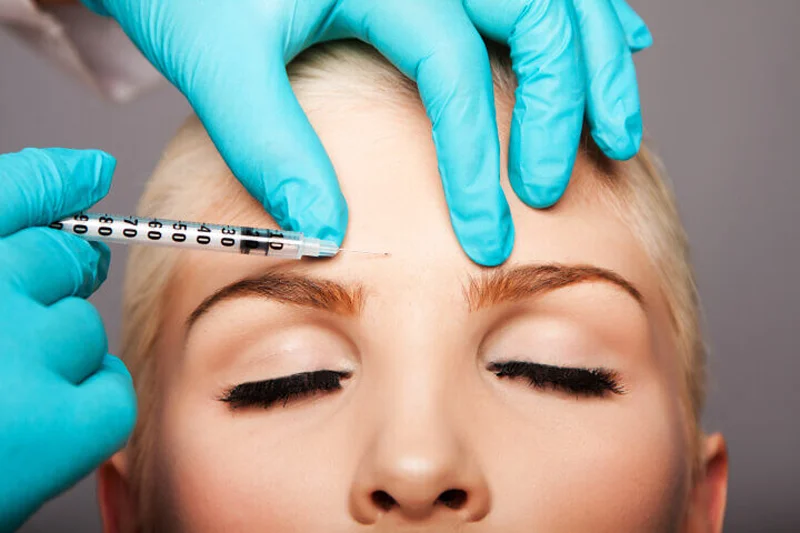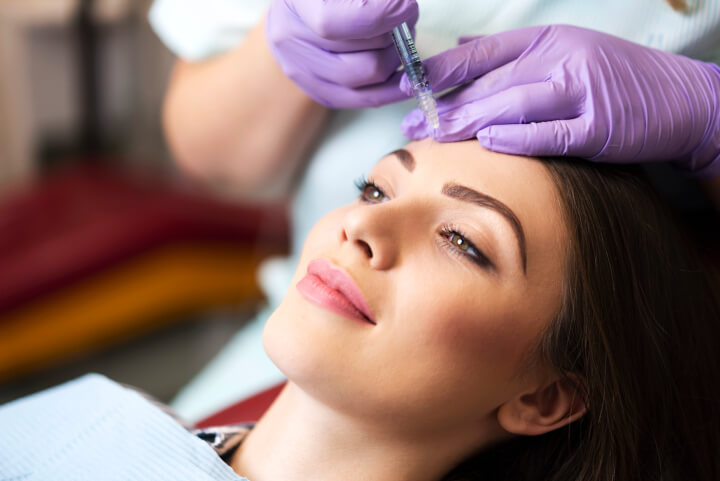Heavy Forehead After Botox: What Causes It?

The sensation of heaviness in the forehead is an uncommon side effect of Botox treatment. Luckily, it’s easily treatable. Botox is a protein that has been purified and treats wrinkles triggered by facial expression. Such wrinkles include horizontal forehead lines that appear across the forehead when raising an eyebrow, the vertical lines between the brows when people frown, and the crows feet that show around the eyes when squinting or smiling.
So what causes a heavy forehead after Botox? From the brow arch to the hairline, the frontalis muscle runs. This forehead muscle’s movement is what causes a forehead wrinkle. Botulinum toxin incapacitates the frontalis muscle, prohibiting it from moving and, as a result, preventing horizontal wrinkles. However, the frontalis muscle is in charge of raising the eyebrow. Crippling these muscles will cause a heavy eyebrow and forehead.
With just a few simple injections, our providers can erase your wrinkles and fine lines in no time with Botox. Call us today to book your appointment.
Why Does Your Forehead Feel Heavy After Botox?
Patients experiencing a heavy brow after Botox and concerned about eyelid ptosis and a puffy eye due to toxin are typical. Botulinum Toxin-A was initially used cosmetically in the mid-1980s, and its popularity has since skyrocketed.
Toxin practices accounted for 1.8 million of the nearly 10 million therapies performed by the American Society for Dermatologic Surgery in 2015. Nevertheless, there’s considerable variation in toxin treatment results due to a lack of standardized training, pharma company-led advertising, and poorly regulated practice.
Excessive Botox can cause the forehead to relax too much, resulting in that heavy feeling. It can feel like an elephant is sitting on the eyebrow. And once the heavy brow droop, so does the upper eyelid. Drooping eyebrows cause hooded eyelids since some people with excess eyelid skin raise their brows a lot to make their eyes look bigger.
It appears like a lazy eye to some people. Understanding facial anatomy and observing individual variations are required. If the plastic surgeon fails to assess how much the patient uses this facial muscle, excessive Botox will cause patients to have a droopy eyelid.
Cause and Prevention of Forehead Heaviness After Botox Injection
The majority of upper-face creases are caused by creating facial expressions. Botox calms the muscles in the face that make a facial expression. When the muscles are relaxed, they can’t contract vigorously, which can cause a drooping brow. The three major muscle groups influence the brow position.
The frontalis is a flat, thin muscle on the upper forehead that raises the brow. When the frontalis contracts, it lifts the brows from the hairline to the eyebrows. Repetitive frontalis contractions can cause horizontal wrinkles on the upper forehead over time.
Botox targets these wrinkles by calming the frontalis muscle, which can make raising the brows hard. Botox targets these wrinkles by easing the frontalis muscle, resulting in a tricky brow lift.
The glabella is the muscle complex located between the brows. When the glabellar muscles contract, the inner part of the brows moves downward and inward. When these muscles are used repeatedly, they form vertical frown lines in this area. Botox eases these muscles, making it harder to pull the inner brows down.
The orbicularis oculi muscle is located around the eyes. When this muscle contracts, the skin around the eyes constricts. When people use this muscle to grin or smile, the brow tail getting down will be visible when closely observed. A patient can’t pull the brow tail down as it was before if this muscle is eased with Botox.
As previously mentioned, several muscles move the brow. Some lift them, while others lower them. Some focus inside the brows, while others focus on the outside. The brow position can change if one of these areas is relaxed by Botox while other muscles remain tight.
The heavy brow is obtained in this. It’s more difficult to lift the brows when they feel heavy. It only occurs when Botox is used to relax the frontalis muscle. People with horizontal forehead lines do this. They either don’t have frown lines or crow’s feet or don’t mind the other creases.
The muscle that usually elevates the brows relaxes while the muscle that lowers them remains active with Botox treatment. As a result, a patient will feel a heavy forehead or brow, and their position may appear downwards. It can also cause hooded eyes or eyelids.
It means applying makeup in the eye area will be more difficult. It’s vital to address all of the muscles surrounding the brow to avoid brow ptosis. Even if the frown lines or crow’s feet are present or not, a person should still get a little Botox in these areas.
It will counteract the effect of Botox on the frontalis muscle and relieve the forehead heaviness. Moreover, by elevating the soft tissue, forehead skin, and brow, brow lift surgery can also enhance the forehead’s appearance, brow, and the muscles around the eyes.
Learn More: How many Units of Botox Should be Used on The Forehead?
Other Botox Injector Mistakes
Eyelid Droop
Also known as eyelid ptosis, it’s the most common complication but also the most uncommon. For the most part, the drop in the forehead and brows causes the heaviness on the eyelid.
Call the doctor when having difficulty opening the eyes. There are eye drops prescriptions that can transiently lift the eyelid. They help manage this issue until the Botox effects wear off.
Lop-Sided Smile
Incorrect injection of the muscles that control the mouth structure leads to one side of the smile pulling up and down. It’s usually more apparent when the face is moving, but that’s not always the case.
There are several ways to improve the appearance of this until the Botox wears off; it’s advisable to consult with a Botox expert.
One-Sided Facial Droop
Luckily, this is uncommon. An injection site around the lower crow’s feet or eyelid typically travels to a muscle that raises the edge of the lip and parts of the cheek. A patient must wait for it to wear off on this one.
The Lower Eyelid Is Looking Worse After Botox
Generally, it’s caused by excessive relaxation of the orbicularis oculi muscle around the eye. Botox in the crow’s feet area will worsen the puffiness on the lower eyelid, especially in some people with a possibility to loosen that muscle over time.
Consult a doctor about possible solutions. The upper eyelid dermal fillers treatment to tighten or smooth the drooping eyelid skin may be helpful. Sometimes the only solution is to avoid utilizing Botox in specific areas of the muscle.
Learn More: Side Effects of Botox on Forehead
Lop-Sided Facial Attributes
Botox is increasingly being utilized in the lower face by more injectors, but it’s not always well executed. It eventually results in patients having frequent visits to an aesthetic clinic to correct a bad Botox mistake.
Find a Great Aesthetician at aNu Aesthetics™ for Botox Treatment

aNu Aesthetics is pleased to provide patients in and around Kansas City with a broad range of the industry’s most advanced med spa and wellness treatments. We make an unwavering commitment to every patient, providing a personalized treatment plan to assist them in achieving their wellness and beauty goals.
aNu Aesthetics is here to help with whatever you require. We have it all, from Botox brow lift to eyelid surgery. Also, we provide other services such as endoscopic brow lift and eyelid lift treatments. Experience world-class cosmetic surgery and care. Call or email us today to get a free consultation or to schedule your next appointment.
With just a few simple injections, our providers can erase your wrinkles and fine lines in no time with Botox. Call us today to book your appointment.